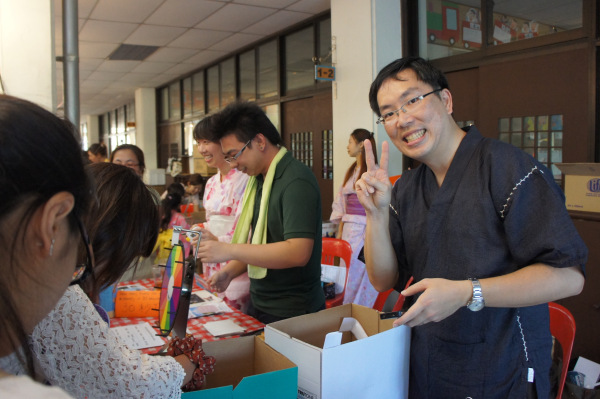Let’s Talk Japan Podcast, Episode 19 – Japanese Translation & Interpretation
Let’s Talk Japan is a monthly, interview format podcast covering a wide range of Japan-related topics. Host Nick Harling (Mie-ken, 2001-03) lived in Japan from 2001 until 2005, including two great years as a JET Program participant in Mie-Ken. He practices law in Washington, D.C., and lives with his wife who patiently listens to him talk about Japan . . . a lot.
In this episode, Nick speaks with Stacy Smith about the joys and challenges of working as a professional Japanese translator and interpreter. Stacy worked as a Coordinator of International Relations (CIR) for the Japan Exchange Teaching (JET) Program in Kumamoto prefecture before eventually returning to the United States and turning her love of Japanese into a career. When not on the road with work, Stacy lives in New York City.
Together they discuss how Stacy became interested in the Japanese language; how she went about deciding to become a professional translator & interpreter; the impact of technology; and tips for improving your own Japanese study habits
To learn more about Stacy, check out her website as well as her blog posts for JETwit. Also, here’s a great article about Japanese translation and interpretation.
If you have not already done so, be sure to “Like” the podcast on Facebook, and follow the podcast on Twitter @letstalkjapan. Additionally, please consider leaving a positive rating and/or review in iTunes.
Kyodo News “JET Alumni” series: Jenson Deokiesingh (Toyama)
News agency Kyodo News has recently been publishing monthly articles written by JET alumni who were appointed in rural areas of Japan, as part of promotion for the JET Programme. Below is the English version of the column from December 2013. Posted by Celine Castex (Chiba-ken, 2006-11), currently programme coordinator at CLAIR Tokyo.
*********
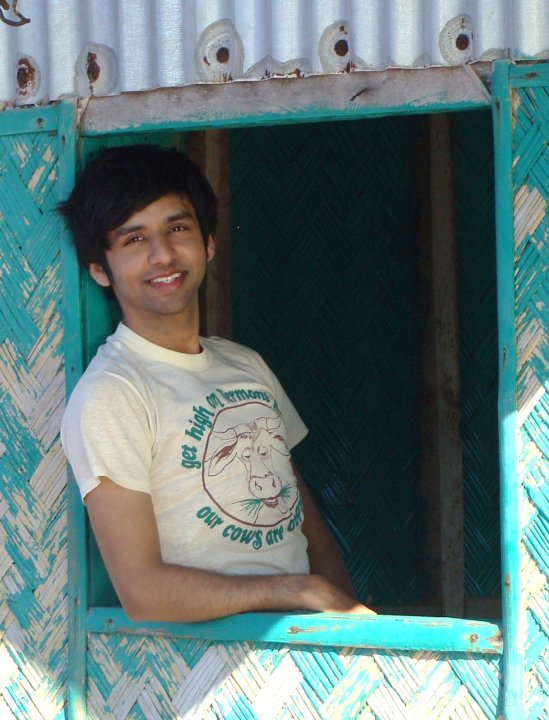
I am reminded that my love story was very much a mutual one and I fondly think, “In life we meet, only to part, so we can meet again.”
Untitled
I have always loved Yayoi Kusama. There’s an unexplainable magic and unorthodox beauty about her signature polka dot patterns. I had seen compelling images of her kaleidoscopic, “Love is Calling,” installation designed specifically for the Mori Art Museum’s 10th Anniversary Exhibition and immediately knew I had to see it.
On September 1st, my last day in Japan and ironically the last day of the “All You Need Is Love” exhibition, I went searching for Kusama to bid her a final farewell.
As I meandered from one provocative exhibit to another, I found myself riveted to the entrance of the section, “Losing Love”. Written on the stark white wall, in simple black text, were the words: Great love stories are often about the encounter with and subsequent loss of loved ones. I stood there, in a trance, repeating these words, over and over, until they became deeply etched in my memory.
A film of tear glazed my dark brown eyes; wedged in my throat was a painful lump; and my heart slowly crumbled with each excruciating beat it gave. The inevitable truth I was desperately trying to avoid was now blinding me in a sobering reality. My life as a JET, my Japanese love story, was irrefutably over.
On Friday, October 18th, I had my first job interview since returning to my vibrant and colourful country of Trinidad and Tobago. Truthfully, the interview was going terribly. A frightening combination of nerves and adrenaline had left me uncharacteristically inarticulate. I was about to cite it as one for the history books, when the interviewer inquisitively said, “Please tell me about your experience on the JET Programme.”
That one sentence was all I needed to give me the confidence I had momentarily lost. With an inescapable smile imprinted on my face, I gleefully declared that living and working in Japan have been incontrovertibly the best experience of my life thus far. And, it truly was.
My first years in Toyama are as vivid and clear as Toyama’s spring mountain waters. The hot embarrassment pulsating through my body as I wished the staff after a long day’s work “Gochisousama deshita (Thank you for the feast)” instead of the customary “Otsukaresama deshita (Thank you for your hard work)” still turns my brown cheeks rouge. Excitedly waking up early in the morning for my first school photo, wearing my best suit, whistling as I biked to work, and then having a crow defecate on my new suit still brings me uncontrollable laughter. Taking a lunch break at the school’s garden, reading Haruki Murakami’s “Sputnik Sweetheart” and then being stung by a several caterpillars still gives me chills. However, crazily running into the staff room, shouting, “Itai! Abunai! Itai! (Pain! Dangerous! Pain!)”, and having my vice principal heroically take the school’s vacuum to vacuum my back change those shudders into immeasurable smiles. Read More
Kyodo News “Rural JET alumni” series: Elizabeth Gordon (Iwate)
News agency Kyodo News has recently been publishing monthly articles written by JET alumni who were appointed in rural areas of Japan, as part of promotion for the JET Programme. Below is the English version of the column from November 2013. Posted by Celine Castex (Chiba-ken, 2006-11), currently programme coordinator at CLAIR Tokyo.
*********
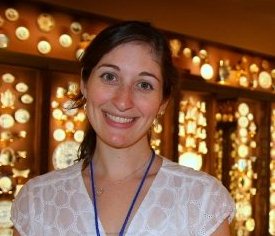
“I discovered through these exchanges that the people with whom I was talking wanted to know as much about me, about Chicago and about America as I wanted to know about them, Iwate and Japan. Through these interactions over the course of two years I began to gain a small understanding of the subtle nuances that were part of the culture in which I was living.”
Originally from Chicago, Elizabeth Gordon (Iwate-ken, Ninohe-shi, 2003-05) holds a Bachelors Degree in Psychology with a minor in Japanese Studies from Northwestern University, IL, and a Master’s degree in East Asian Studies from Columbia University, NY. She spent two years teaching English in rural Iwate before joining the Japan Foundation in New York as a Program Officer. She currently works as the Director of Private Events of the Adler Planetarium in Chicago.
Soba Diplomacy
Noodle making is an art, not to be taken lightly. Only a true master can produce the perfect noodle. After the wooden board is cleaned, the ingredients are kneaded in perfect rhythm until the correct consistency is achieved, and only the master knows for sure when that is. The rolling pin goes back and forth in a circular motion but forms a perfect rectangle, which is folded in half, then in half again, and in half again. Ever so delicately, the master cuts, slice after slice, all exactly the same width. They are cooked for just the right amount of time and then served with a simple dipping sauce sprinkled with scallions. The movements were ingrained in his muscles. I imagine he could have completed the whole process with his eyes closed. There is simplicity in the process, but the flavor is layered and complex.
When I arrived in Ninohe City, Iwate Prefecture in the summer of 2003 as a participant on the JET Program, I did not know a soul, nor had I ever heard of Iwate Prefecture. There was a short orientation in Tokyo, followed by a shorter orientation in Iwate’s capital city of Morioka. It was on the final day of orientation in Morioka that I met my supervisor, Mr. Sato. He picked me up and we drove the one and a half hours through the countryside back to Ninohe City. Mr. Sato did not speak much English and his heavy Iwate dialect was difficult for me to understand. We did, however, find common ground in a little bit of sports but mostly through food. I listed all of my favorite Japanese dishes, and he loved the fact that I could eat with chopsticks. He brought me to the Board of Education office and showed me my desk, which would be my home base for the next two years.
There was no rest for the weary, however. Before I could sit down I was whisked away on a driving tour of the entire city. We stopped at my two junior high schools and one of the eight elementary schools at which I would be teaching. I was asked to give a short self-introduction at each location. We also stopped at city hall to meet the mayor, and at the bank to open an account. Back at the board of education it was suggested that I be taken to the grocery store before I was dropped off at home for the evening. Read More
Kyodo News “Rural JET alumni” series: Nic Klar (Niigata)
News agency Kyodo News has recently been publishing monthly articles written by JET alumni who were appointed in rural areas of Japan, as part of promotion for the JET Programme. Below is the English version of the column from October 2013. Posted by Celine Castex (Chiba-ken, 2006-11), currently programme coordinator at CLAIR Tokyo.
********
Originally from Australia, Nicholas Klar (Niigata-ken, Itoigawa-shi, 1995-97) wrote the book “My Mother is a Tractor” about his life as an ALT in Omi, Itoigawa, Niigata-ken. After JET he worked for many years as a college counsellor and History teacher in international schools before returning to Japan to live. He now runs a small business in the Japan Alps, “Explore the Heart of Japan” as well as a popular travel website (http://myoko-nagano.com).
Remember that here all is enchantment, – that you have fallen under the spell of the dead, – that the lights and the colours and the voices must fade away at last into emptiness and silence. –Lafcadio Hearn
It was a stark winter’s day as usual in Niigata-ken, grey like sodden blanket. Not one that I had set out on seeking ghosts, but it suited the mood. As I changed trains in Naoetsu for Ōmi the old tempura stand I had been hoping for a snack at was still there, but today it was closed. It seems even the sturdy yukiguni could not stand the sort of weather that was being hurled at them this winter from across the Japan Sea. I settled into my seat, its soft orange covers familiar like an old friend, and waited for the delayed departure. I scrubbed the mist from the brown streaked windows with my hand as the motor idled and the minutes slipped by. Outside schoolboys in their traditional Prussian kit seem oblivious to the biting gusts of artic-like snow. Eventually with the sound of the station attendants whistle the doors snapped shut and the blue and white carriage groaned away from the platform.
As we crossed over the dark frigid waters of the Himegawa almost an hour later I grew excited. I hadn’t been back to the haunts of my old town for years. It was an unplanned visit and no-one really knew I was coming. I looked over for the local chugakko as the train passed by, obscured now by the construction of the new Hokuriku shinkansen. Framed behind those were the mountains I had loved so much. So many times I had taken my bike up into those North Alps making new discoveries, getting lost in the awesome beauty of its nature. Days of sunshine, days of rain. How I missed them. And the ghosts that inhabited them.
To the right there was a slight glimpse of my former apartment block. Not mine anymore, not for many years. In fact I think it now lays empty, apart from maybe a ghost or two, as the town depopulates. Tall, grey, forbidding – once referred to by a friend as, “…classic 1950’s communist Romanian style architecture”. The memory of that remark brought a brief smile to my face. Yet, it is the only place I will ever live in that has a sea view at the front and the mountains at the back. Grand views of God’s great vista on tap.
When the doors clunked open at Ōmi eki it was if nothing had changed. The chimes rang the same they had all those years ago and the black asphalt platform lay several centimetres thick with windswept snow. It felt soft under my feet as I began my ascent up the cold cement stairs. Standing in his post was my first metaphorical ghost – Watanabe-san the station master in the same blue-clad uniform, looking not a whit older than when we had last met a few years ago. He didn’t recognise me of course, even though I had taught his daughter at Ōmi chugakko. During my stay many of the station attendants had greeted me by name each time I passed through the gate. The inside of the station was a time capsule still painted the same green, apart from a more modern poster here and there, populated by even more ghosts of my memories. Local oba-chan in the waiting room still sat chatting on wooden bench seats around the kerosene heater behind glass doors. The three old shuttered-up ticket windows still existed – a sad reminder from the more grandiose boom days of Ōmi. Perhaps they were stubbornly retained in the forlorn hope that those times may yet return once again. Read More
CLAIR Magazine “JET Plaza” series: Anthony Bianchi (Aichi)
Each month, current and former JET participants are featured in the “JET Plaza” section of the CLAIR Forum magazine. The November 2013 edition includes an article by JET alumn Anthony Bianchi. Posted by Celine Castex (Chiba-ken, 2006-11), currently programme coordinator at CLAIR Tokyo.
********
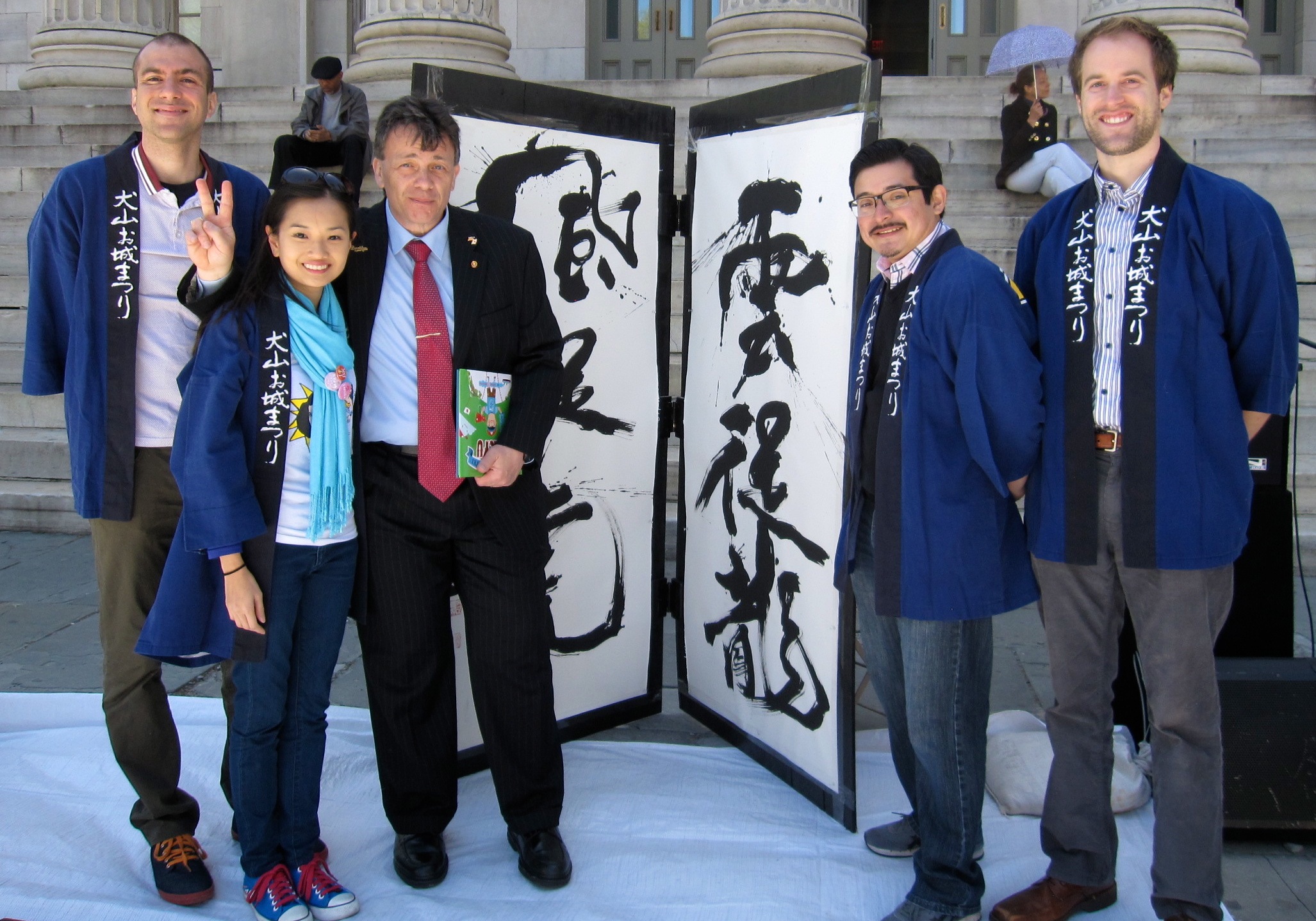
“Once you are in the programme, you are in the programme for life. As an Italian kid from the streets of Brooklyn, I get that. Like they say, when you’re a JET you’re a JET all the way, from your first cup of tea to your last hanami.”
A native of Brooklyn, New York, Anthony Bianchi (Aichi-ken, Kiyosu City, 1989-91), graduated from New York University with a degree in film making. After working on a number of television programs in Hollywood, he joined the JET Programme and spent two years working as an ALT in rural Aichi. A few years later, after overcoming many difficulties, he started the Native English Teacher (NET) Program, a teachers programme tailored for Inuyama City. Feeling there was a wall between the citizens and the city hall, he decided to run for the office and was voted into the city council of Inuyama City, Aichi Prefecture in April 2003. Anthony is currently serving his third term.
JET Generations
As anyone who has done so knows, living and working overseas in a different culture has a profound effect on all sides.
I have written before about how being on the JET Programme changed my life. To make a long story short, I would definitely not be here in Inuyama doing what I am doing had I not been involved in JET. Sometimes it still amazes me how things worked out. I mean, sometimes while I am making an argument on the council floor about some very local issue I still think, “How in the world did I end up here?” Conversely, I wonder at times what I would be doing if I had not joined JET some 25 years ago. Definitely something very different and most likely not as rewarding.
But the JET experience is certainly not only about what you get out of it, as I mentioned at the top, it is about the effect it has on all sides. As time passes I realize more and more that being a JET alumnus is a living thing that goes on after your contractual duties end. I still meet people involved with the programme that leads to great relationships and opportunities. Especially opportunities to give others even a small glimpse into another culture like the one we had by being part of the JET Programme. I am always impressed by the willingness of JET alumni to give back. A couple of summers ago I was asked to be on a panel at a national conference in Washington DC. Of course, there again, I met many outstanding alumni who are doing great things to promote cultural exchange and understanding between Japan and their home country. But I also realized that there is something about meeting former JET participants that has a camaraderie that is different and,in many ways, surpasses any other alumni association that I have known. I include in this group also Japanese staff and officials who have worked on the programme.
I would like to talk about a recent example. Out of my office, we run an exchange program called B. Bridges. We are a volunteer exchange group in our tenth year of existence. The idea for the group was seeded at an event the Brooklyn Borough President,Marty Markowitz, held for me at Borough Hall after my first election in 2003. There I was reacquainted with the administration of Xaverian High School. On that same trip I visited the school before returning to Japan. During that visit we decided to hold some kind of exchange.
JQ Magazine: 2013 JETAA Oceania National Conference Spotlights Sister City Relationships
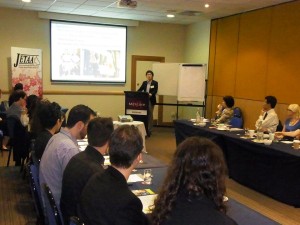
Hiromi Hakuta, assistant director of CLAIR Sydney, addresses alumni at the JETAA Oceania National Conference, Brisbane, Nov. 2013. (Courtesy of Hiromi Hakuta)
By Eden Law (Fukushima-ken, 2010-11). After the JET Programme more than fulfilled its promise of “an experience of a lifetime,” Eden returned to Sydney, Australia, where he joined the JETAA New South Wales chapter to take advantage of the network and connections available to undertake projects such as an uchiwa design competition for the Sydney Japan Festival. He also maintains the JETAANSW website and social media. Other than that, he’s a web designer and a poet, gentlemen and raconteur.
One of the best things about being a member of JETAA is the community, and over the weekend of 15-17 of November, the Oceania community of JETAA got together for our annual antipodean regional conference. For those of you up north who don’t know, JETAA Oceania comprises of five Australian chapters (the state chapters of Queensland, New South Wales, Canberra, the uber-chapter of South Australia-Victoria-Tasmania, Western Australia) and three New Zealand chapters (South Island, Auckland and Wellington). Representatives from Sydney’s CLAIR office (Tsuyoshi Ito, Hiromi Hakuta and Julien Ansart) attended as observers of the proceedings. This year, JETAA Queensland played host in Brisbane, the northern capital that looks to Asia and is close to the Gold Coast, a favoured destination for young Japanese looking for sun, surf and sand. Appropriately, we had our first lunch meet on Friday at MOS Burger, the famous Japanese fast food chain whose only non-Asian presence internationally is right in Brisbane.
JETAA Oceania was invited to attend the Welcome Back Reception for returning JETs at the Japanese Consul General’s home in Brisbane on the Friday night, a chance of course for us to network and hobnob with the cream of Brisbane’s Japanese cultural community. And after the reception finished (early, predictably), JETAA kicked on in town for a night out (hint: it’ll always involve karaoke—usually lots of obscure Japanese songs sung by that one quiet serious person who turns into a blurry, hip-thrusting maniac).
The first day of the conference began on Saturday, early (for some, too early) at our hotel and Laura Tasharofi, president of JETAA Qld, began proceedings by explaining the theme of this year: Australia-Japan sister-city relationships. As explained by Hakuta-san, of all countries, Japan has the most links in Oceania, with 108 sister city relationships in Australia and 44 in New Zealand. Therefore, the potential for JETAA to get involved is great, and the conference’s objective is to find ways to participate and be more prominent in our local communities. To start discussions and provide ideas and examples, two guest speakers, Ross Humphreys and Barry Hancock, were invited who are respected members of the Brisbane community and its influential sister city relationships.
Japan News: Tokyo to increase number of JETs significantly in 2014 in anticipation of Olympics
Great JET news from The Japan News (i.e., Yomiuri Shimbun)! Apparently Tokyo Governor Inose also announced that Tokyo will increase the number of its hiring JET participants from 5 to 100 in 2014, and to 200 from 2015. Also, from conversations I’ve had, it sounds like representatives of the Tokyo Metropolitan Government developed a very positive impression of JET based on various interactions they had with JETAANY during visits to NYC.
Tokyo English teachers to study abroad for Olympics
November 7, 2013
The Yomiuri Shimbun
The Tokyo metropolitan government will send about 200 young English teachers from middle and high schools to English-speaking countries every year for three months to brush up their English teaching abilities in anticipation of the 2020 Tokyo Olympic and Paralympic Games, sources said Thursday.
The program, designed to beef up the English ability of teachers as well as their teaching abilities, will start in the next academic year in April. Many foreign visitors are expected to come to Tokyo during the Olympics and Paralympics in 2020, according to the sources.
The number of assistant language teachers (ALTs) at metropolitan-run high schools will also be increased.
The metropolitan government plans to appropriate about ¥1 billion in next fiscal year’s budget. Through improvement in instruction capacities at schools, it plans to improve students’ language abilities, the sources explained.
Currently there are about 3,000 English teachers at public middle schools and high schools in Tokyo. Of them, about 200 teachers in their third year of employment will be sent to overseas universities and other educational institutions in English-speaking countries every year. They will attend English lessons and learn English teaching methods during the three-month period.
The metropolitan government also plans to increase the number of ALTs at metropolitan high schools, about 200 at present, to 300 in the next academic year and 400 in the academic year of 2015.
The Tokyo government plans to utilize the Japan Exchange and Teaching (JET) Program, an international exchange program coordinated by the central government for local governments to invite young foreign nationals to teach English as assistants.
JQ Magazine: JETAA USA Earthquake Relief Fund Aids Recovery
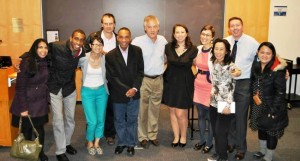
Taylor Anderson Memorial Fund founder Andy Anderson (center) with members of the JET Alumni Association of New York at Columbia University, Oct. 30, 2013. (Courtesy of JETAA New York)
By C-M Daeley (Saga-ken, 2008-2011) for JQ magazine. C-M is a poet, rap lyricist, and travel enthusiast currently working as an English teacher in Tokyo. For a look at some of his other writing, poetry and lyrics, check out his blog at http://spikedaeley.wordpress.com.
With today’s 24-hour global news cycle, it is sometimes difficult to keep even the most severe events in public memory. The Great East Japan Earthquake that struck on March 11, 2011 has not received much recent coverage in global news, but the issues faced by those still rebuilding remain monumental. Fortunately, there has been significant international aid from a number of sources, one of which is the JETAA USA Earthquake Relief Fund. This grant has raised almost USD $90,000 and has been used to provide seed funding to assist grassroots programs in areas severely impacted by the earthquake.
Due to the complex nature of fund allocation, this article will focus mainly on projects and programs directly supported through JETAA funds. However, it is significant to note that the Earthquake Relief Fund was only one of several avenues used to bring aid to the region and that, to date, roughly $500,000 has been raised through JET-affiliated groups and organizations worldwide. Jim Gannon (Ehime-Ken, 1992-94), current executive director at the Japan Center for International Exchange in New York, and Jessyca Livingston (Hokkaido, 2003-06), one of the three JETAA USA Country Representatives serving during the immediate aftermath and current JET Program coordinator at the Consulate-General of Japan in Denver, spoke about some of the initiatives the Earthquake Relief Fund has helped support.
“It is very difficult to give a concise yet comprehensive picture of what the JETAA funds have done,” Gannon explained. “The best way to describe it is that they have played a catalytic role in supporting some key projects in the early stage that have been supported by a range of others in more generous fashion once they proved their merits. JETAA cannot take full credit for all of the successes, but it did play an important role in getting things moving.” He also noted, “The real heroes are these incredible people from Tohoku who have championed these projects, the inspirational young people who have relocated to Tohoku to help operate them, and those who have been shuttling back and forth from Tokyo and elsewhere to help formulate and drive these initiatives.”
After a national discussion and several rounds of voting in each of JETAA USA’s 19 chapters, a final decision was made about how the fund should be allocated. “In the end, it was very obvious that chapters found it important to support education-related efforts in those areas most affected,” Livingston said.
AJET launches “JET Community Service Tracker 2013-14”
I’d heard about this great idea from AJET Chair Kay Makishi a little while ago, and now it’s up and running! A really innovative way to show another form of Return On JET-vestment:
JET Community Service Tracker 2013-2014
https://docs.google.com/forms/d/1QzQif7qeluJBzfnCgQuseZ4FVJlnMETaN65mEBYh6cA/viewform
![]()
This year, National AJET has set some very ambitious goals for JET community involvement: 1,000,000 yen raised for charity, and 10,000 volunteer hours of community service. For any volunteer event, charity event, or fundraising campaign, large or small, please fill out this form. Whether you raised 100,000 yen, or 1,000, we’d love to hear about it. Whether 100 people volunteered for 10 hours, or two people volunteered for one hour, we want to hear about it!
JET Community Service Tracker:
AJET proudly introduces JET Community Service Tracker! This form is designed to collect data on volunteer hours served and charity money raised by JETs around Japan. You can enter figures for the entire JET-year: August 1, 2013 through July 31, 2014. The information allows AJET to share the positive impact JETs make in their communities with the Japanese Ministries that support JET and with the Japanese public, and help other groups increase the success of their own volunteer and charity efforts.
Race to the Top Challenge:
AJET also proudly presents the Race to the Top Challenge. This challenge will run for six months, from November 1, 2013 through April 31, 2014. Fill out the JET Community Service Tracker and win up to 60,000 yen to support your next volunteer or charity event!
How to Win:
That’s easy! Just be the most caring, dedicated, AJET Chapter you can be! Then, log all of the awesome things you do in the JET Community Service Tracker from November through April. For any questions regarding how to record your community service (what counts/what doesn’t) please contact exec@ajet.net
The Prizes:
One prize of 30,000 yen will go to the prefecture with the largest number of community service hours. A second prize of 30,000 yen will go to the prefecture with the largest amount of charity money raised. The winners will be determined on a percentage basis in order to account for the differences in JET population from prefecture to prefecture.
Who is Eligible to Win?
Any official AJET Prefectural Chapter is eligible to win one or both of these categories for a total of up to 60,000 yen. The winning prefecture(s) will be announced in the May issue of Connect Magazine.
Disclaimer:
The AJET National Council reserves the right to revoke prize money in the case of misconduct including but not limited to inaccurate recording, intentional lying, and unethical actions as determined by the Council. This contest is sponsored by the AJET National Council, a volunteer organisation of current JET participants elected and appointed by current JET Programme participants to represent the JET community nation-wide.
JQ Magazine: 2013 JETAA National Conference in Minneapolis Recap
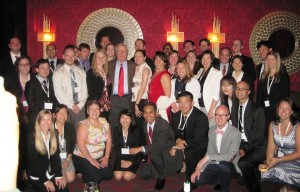
JETAA USA National Conference participants in Minneapolis with former Vice President of the United States Walter Mondale, Sept. 26, 2013. (Courtesy of Yeu-Li Huang)
By Yeu-Li Huang (Yamanashi-ken, 2007-2010) for JQ magazine. Yeu-Li is the current chapter secretary of the JET Alumni Association of the Southeast (JETAASE).
MINNEAPOLIS, Minn. – The JET Alumni Association of Minnesota (JETAAMN) hosted this year’s USA National Conference from Sept. 26-29 with assistance from the Ministry of Foreign Affairs (MOFA) and the Council of Local Authorities for International Relations (CLAIR). Attendees included delegates from all 19 JETAA USA chapters, as well as representatives from CLAIR, MOFA, and the Consulate General of Japan at Chicago.
Each national conference spotlights particular challenges facing the JETAA community. This year was no different, as critical topics included continuation of the JETAA national initiatives, common issues facing JETAA chapters, membership outreach, and collaboration between JETAA chapters and other Japan-related organizations.
Thursday, Sept. 26
The conference got underway with an evening reception at the restaurant Crave, featuring former Vice President of the United States Walter Mondale as a special guest. A native Minnesotan, Mondale was also the U.S. ambassador to Japan from 1993-96. In his speech, Mr. Mondale praised the work that the JET Program has done in building personal relationships between Japan and the U.S., and called for “JETers” to continue fostering those ties.
JETAA Singapore’s Natsumatsuri!
Thanks to JETAA Singapore’s Eugene Neubronner (Hiroshima-ken, 2010-12) for sharing this great update:
“This is Eugene Neubronner from the JETAA Singapore Chapter committee. We recently had our own Natsu Matsuri and we’ve finally gotten around to posting up pics and a writeup. Would love it if you guys could feature it and link to it as we’re always looking for more people to come on down who are ex- and interested JETs!”
Natsu Matsuri 2013
Back in August, Singaporeans, Japanese and everyone else came together to enjoy one of Japan’s favorite events during summer, the Natsu Matsuri. While it is unfortunate that Singapore has a very controlled use of fireworks and firecrackers, that didn’t mean we couldn’t have any fun. JETAA Singapore members were out in force as well, with our own booth to drum up interest in the JET Programme.
JETAA Singapore’s booth was a collective grab bag of games and information on the JET Programme, and saw a surprisingly strong interest that threatened to overwhelm our members and committee staff on hand. Many clamored for the Japanese games we had – including a haiku contest, match-the-word and more – but others were also interested to find out more about the JET Programme, something our ex-JET members were more than happy to talk about. Here’s to hoping more people apply and discover the joys of living and teaching in Japan!
Held at the Japanese Primary School in Singapore’s Changi, the annual event sees thousands of people attending – many dressed in their own yukata. The 2013 Natsu Matsuri was the 26th to be organized by The Japanese Association of Singapore. It features dozens of stalls hawking traditional Natsu Matsuri food, games and a massive stage for performances throughout the evening culminating in a Bon Odori dance everyone’s invited to join in on.
If you happen to be living in Singapore and is an ex-JET (Singaporean or otherwise) who’s somehow not on our list, do reach out to us! We’d love to get to know more of you. JETAA Singapore holds regular events and meet-ups. Do email us at secretaryjetaasingapore [at] gmail [dot] com.
お疲れさまでした〜
Click here for the full post and to see more photos from the event: http://jetaasg.wordpress.com/2013/10/18/natsu-matsuri-2013/
CLAIR Magazine “JET Plaza” series: Suzanne McMillan (Ehime)
Each month, current and former JET participants are featured in the “JET Plaza” section of the CLAIR Forum magazine. The October 2013 edition includes an article by JET alumn Suzanne McMillan. Posted by Celine Castex (Chiba-ken, 2006-11), currently programme coordinator at CLAIR Tokyo.
********

“Working in the media and recruitment space requires a high level of networking ability and the confidence to quickly reach out and engage with new people. My time spent in Japan provided me with this skill set along with resilience and the ability to adapt quickly to changing circumstances.”
Originally from Northern Ireland, Suzanne McMillan (Ehime-ken, 1998-2001) holds an MA in History from Aberdeen University in Scotland. Her media career began in the UK when she joined the BBC initially as Researcher and later as an Assistant Producer. She has held the positions of Chairperson within the JETAA NI Chapter and NI Country Representative within JETAA International. Suzanne is currently a Project Manager and BDM Executive at Webpublication in Sydney, Australia where she coordinates digital publishing projects.
The Time of my Life
Nervously twiddling my thumbs, I sat before the interview panel and hoped that my answers would bring me a step closer to my long awaited place on the JET Programme. What had brought me to this point in my life? Well, as a child a favorite uncle had told me many tales of his exotic life in Japan and passed onto me the gift of a hand towel imprinted with a map of Shikoku. This tattered piece of history proudly hung on the wall of my university dorm room and later traveled with me on my flight to Tokyo Orientation; beginning my new life in Japan.
For the next three years, life as an ALT provided so many memorable experiences. I shared stories with teachers, students and fellow JET participants; discussing UK sports, changing political events in Northern Ireland and the different approaches to education and family life. Local neighbors became my friends and my knowledge of Japanese history grew with any tale they would tell of their past. The world seemed a smaller place and I realized the impact of JET; cultural exchange that reaches a deeper level and enables lifelong friendships that are priceless.
Even now memories of JET spring to mind during everyday tasks; the particularly cold winter when the supervisor at my BOE bought all JET participants a puffer jacket to keep warm, ensuring that we could all be spotted at a distance of 100 meters waddling with the extra bulk. Warmth feels my heart when I recall the kindly teacher who delivered boxes of mandarin oranges to your front door if you happened to be sick. I have never been able to hold a mandarin since without seeing his caring face. And yes, I hold myself fully responsible for many Japanese adults who I taught when they were kindergarten age and who now having an Irish lilt to their accent after repeating key English words after me several times over. Read More
Life After JET: It’s Hip to be Square
Recently posted on JETAA NSW site by Eden Law (Fukushima-ken, 2010-11):
The JET Programme has lead to many opportunities and careers, sometimes rather unexpectedly. Our Life After JET articles by former JETs gives an insight about their lives after the programme, and how it has shaped their careers and paths. We hope that it will prove useful as an insight for potential applicants into what we as ex-JETs got from our experience, and maybe provide some nostalgic memories for others. Please feel free to contact us if you want to write about your own experience!
Kenneth Pinyopusarerk, who hails from Canberra, Australia, was a 2003-2006 CIR who worked in Saigawa (now Miyako), Fukuoka-ken. A man with a lifelong passion for two things: Japanese culture and computer games, he managed to combine the both and land a dream job at Square Enix in Tokyo where he currently works today. The only downside to his job is having to turn down countless requests from friends for “A Realm Reborn”, the latest in the Final Fantasy franchise.
Twenty years ago, on a crisp Sunday morning in Canberra, I had a life-changing encounter. I was strolling through the local Trash & Treasure when I stumbled upon a pre-loved cartridge of Final Fantasy II*, lying upon a splintery foldout table. Drawn by some unknown force, I paid the $40 asking price—a small fortune for a 14-year-old in 1994—without so much as an attempt to haggle. Thus began my enduring love affair with the video game developer Squaresoft, now known as Square Enix. Had my pimply teenage self been told that he would one day work for this company, he would have scoffed and promptly resumed playing whatever game it was he was obsessed with at the time.
Since childhood, I’ve had an affinity with Japanese culture. I attribute this to Read More
Japan Times: “Don’t blame JET for Japan’s poor English” by Debito Arudo
A recent Japan Times piece by long-time contributor Debito Arudo:
Don’t blame JET for Japan’s poor English
BY DEBITO ARUDOU
The Japan Exchange and Teaching Programme, touted as the world’s largest cultural exchange scheme, has brought thousands of non-Japanese into the country to teach at local boards of education. These days, with many government programs being told to justify their existence, a debate is raging over whether JET should be left as is, cut or abolished entirely.
Essentially, the two main camps argue: a) keep JET, because it gives outback schools more contact with “foreign culture” (moreover, it gives Japan a means of projecting “soft power” abroad); versus b) cut or abolish JET — it’s wasteful, bringing over generally untrained and sometimes unprofessional kids, and offers no measurable benefit (see Japan’s bottom-feeding TOEFL test scores in Asia).
The debate, however, needs to consider: 1) JET’s misconstrued mandate, and 2) Japan’s psychotic — yes, psychotic — system of language teaching. Read More
Kyodo News “Rural JET alumni” series: Daneeta Loretta Jackson (Fukuoka)

“My JET programme experience and my seven years in Japan have had a profound influence on me. It changed me into a more peaceful, communal person.”
News agency Kyodo News has recently been publishing monthly articles written by JET alumni who were appointed in rural areas of Japan, as part of promotion for the JET Programme. Below is the English version of the column from September 2013. Posted by Celine Castex (Chiba-ken, 2006-11), currently programme coordinator at CLAIR Tokyo.
********
Daneeta Loretta Jackson (Fukuoka-ken, Buzen-shi, 1993-95) was born and raised in the backwaters of Southeast Louisiana. She was educated at public school where she discovered her love for storytelling. She holds a B.A. in English from Loyola University of the South, an M.A. in English from George Mason University, and an M.A. in the Art and Technique of Filmmaking from the London Film School. Her hobbies are international travel, watching movies, anything having to do with dogs, and sleeping. She works as a writer and filmmaker and is a Creative Producer at the ElekTrik Zoo, an arts partnership she co-founded with her husband, Patrick Jackson. She joined the JET programme in 1993 because she wanted adventure. It had a profound affect on her and changed the course of her life.
I was a JET Programme participant from 1993 to 1995 in Buzen-shi, Fukuoka-ken. I never expected to go to Japan. I never dreamed about it when I was a child like so many of my counterparts did. I don’t mean to sound flippant, but the JET Programme for me was a kind of accident. It is too long of a story to recount here. In short, my husband applied for the both of us. He requested a rural post in Fukuoka-ken because a boy from his Japanese baseball team in California was from Fukuoka. When he got word we had been accepted, he told me we were going to Japan. I had about two months to prepare.
Before I knew it, I was on a plane to Tokyo in July of 1993. The first few days were a whirlwind. The orientation in Tokyo and the jet lag made it seem like I was in some sort of dream. I had no idea what awaited me in the countryside, I couldn’t speak much Japanese, and everything seems so strange… so different from my native Louisiana. Read More



